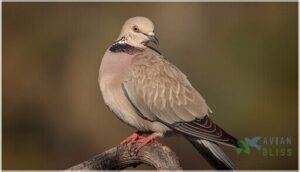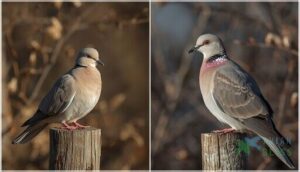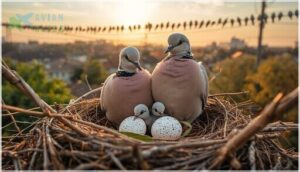This site is supported by our readers. We may earn a commission, at no cost to you, if you purchase through links.
You might mistake the Eurasian collared dove for a common mourning dove at first glance, but that diagnostic black crescent on its nape tells a different story entirely. This medium-sized dove didn’t just wander into North American backyards by accident—it orchestrated one of the most successful avian invasions of the past century, spreading from its native range in southern Europe and Asia to colonize entire continents within decades.
The species thrives in spaces where wild meets human, turning suburban gardens and city parks into prime real estate while outcompeting native birds for resources. Understanding how to identify this adaptable colonizer, where it lives, and what drives its striking success reveals essential insights into modern bird ecology and the shifting dynamics of urban wildlife.
Table Of Contents
- Key Takeaways
- Eurasian Collared Dove Identification
- Habitat and Global Distribution
- Behavior and Social Structure
- Diet and Foraging Habits
- Reproduction and Conservation Status
- Frequently Asked Questions (FAQs)
- Is Eurasian Collared-Dove invasive?
- Is an Eurasian Collared-Dove a pigeon?
- What does it mean when an Eurasian dove visits you?
- What’s the difference between a mourning dove and an Eurasian Collared-Dove?
- Are Eurasian Collared-Doves rare?
- What’s the difference between a Eurasian collared-dove and a mourning dove?
- How did the Eurasian collared-dove get to the US?
- Is a collared-dove an invasive species?
- What are the cultural symbolisms of collared doves?
- How can you care for a collared dove as a pet?
- Conclusion
Key Takeaways
- The Eurasian collared dove’s black neck crescent and squared tail distinguish it from mourning doves, while its pale gray-brown plumage and monotonous three-note call make field identification straightforward once you know what to look for.
- Since 1988, this species has executed one of North America’s fastest avian invasions, spreading hundreds of kilometers annually by exploiting urban corridors, bird feeders, and human-altered landscapes that native species often avoid.
- These doves breed year-round when conditions allow, producing multiple broods with both parents sharing care duties, which drives their explosive population growth and rapid colonization of new territories.
- Their adaptability challenges the simple “invasive equals destructive” narrative—they thrive in niches alongside humans that native birds typically ignore, making their ecological impact more nuanced than outright displacement.
Eurasian Collared Dove Identification
Spotting a Eurasian Collared Dove isn’t as tricky as you might think. You just need to know what features to look for and how they compare to other doves.
Here’s what sets them apart.
Physical Description and Size
Body Proportions set the Eurasian Collared Dove apart—think medium-sized dove with a long, square-tipped tail and broad wings. You’ll spot a slender beak shape and a wingspan stretching 37–40 cm. The black crescent on the nape is a bold marker.
- Squaretipped tail
- Slender, pointed beak
- Noticeable black crescent.
When diagnosing issues like the web server errors, understanding the root cause is vital for resolving the problem.
Plumage and Coloration
Now, let’s talk plumage. Eurasian Collared-Dove stands out with muted feather patterns—think gray-brown tones, sometimes tinged with buff or cinnamon. Adults flash a subtle iridescent sheen on wing coverts when sunlight hits just right.
Color variations shift with season and region, and molting cycles renew plumage. These avian characteristics make bird species identification a rewarding challenge.
Distinctive Markings and Features
You’ll recognize this medium-sized dove instantly by its signature black neck ring—a crescent wrapping the nape, stark against gray-brown feathers. When it takes flight, watch for broad white tail features edging the outer feathers. The pale beak color contrasts with iris shades ranging from light yellow to brown. These avian characteristics seal bird identification every time you spot this dove species.
For accurate species identification, researchers rely on key research methods to classify and study various bird species.
Differences From Similar Dove Species
You can separate the Eurasian Collared-Dove from Mourning Doves by spotting that distinctive black collar—mourning doves lack it entirely. Tail length also matters: this species shows a squared-off tip versus the mourning dove’s pointed one.
Plumage comparison reveals duller feather coloration without the metallic throat reflections you’ll see on some pigeon species.
Call patterns differ too—listen for soft, monotonous cooing instead of varied stutters. Beak structure appears slimmer and darker, helping with bird identification across dove species.
Juvenile Versus Adult Characteristics
Spotting age differences in the Eurasian Collared Dove sharpens your field identification skills. Juvenile plumage differences include duller gray-brown feathers and a faint neck collar, while adults display bold black neck markings. Iris color shifts from dark in young birds to amber-brown in mature ones, revealing important age indicators.
Key age-related features:
- Beak development: Juveniles show lighter, shorter beaks; adults display darker, sturdy bills
- Molt patterns: Mixed juvenile feathers in young birds versus uniform adult plumage post-breeding
- Vocal cues: Softer, less developed coos in juveniles compared to mature territorial calls
- Behavioral markers: Adults exhibit stronger aggression and refined flight displays during breeding
Habitat and Global Distribution
You’ll find Eurasian Collared-Doves thriving far beyond their original territory. These adaptable birds have broken free from their native ranges and colonized new continents with striking success.
Let’s explore where they came from, how they’ve spread across the globe, and what kinds of places they call home.
Native Range in Europe and Asia
You’ll find native populations of the Eurasian collared dove anchored across southern Europe and western Asia, where breeding density peaks in the Balkans, Anatolia, and the Caucasus.
This geographic expansion from core habitat reveals range dynamics shaped by climate impact and agricultural landscapes. Ornithology surveys document year-round residency in these regions, with stable populations thriving despite habitat fragmentation across the Mediterranean basin and adjacent Eurasia territories.
Expansion to North America and Beyond
Since 1988, you’ve witnessed one of North America’s fastest avian invasions: Eurasian Collared Doves surged from scattered Florida introductions to widespread populations across southern and eastern states.
Range expansion continues northward, averaging several hundred kilometers annually in some regions. By 2020, this invasive species had colonized multiple states and parts of Canada, exploiting urban corridors and human-provided food sources to fuel geographic spread.
Since 1988, Eurasian Collared-Doves have stormed northward across North America, claiming hundreds of kilometers annually by hijacking cities and feeders
Preferred Habitats and Urban Adaptability
You’ll find these doves thriving in gardens, parks, residential neighborhoods, and agricultural areas across their introduced range. Urban nesting sites include building ledges and balconies, where their high human tolerance and city adaptation shine.
Suburban expansion accelerates when bird feeders and reliable food sources appear. This urban ecology success story demonstrates striking habitat flexibility—they colonize metropolitan areas faster than native species, exploiting human-altered wildlife habitats and ecosystems with impressive efficiency.
Seasonal Flocking and Dispersal Patterns
These birds don’t migrate long distances—most seasonal movements stay within 1–5 kilometers annually. You’ll notice winter flocks of 10–50 individuals clustering around feeding hotspots, while post-breeding dispersal pushes juveniles 3–5 kilometers from natal sites.
Urban corridors like railways and tree-lined avenues become natural highways for their seasonal migration patterns.
Cold temperatures below 5°C intensify roosting density, reshaping local avian ecology dramatically.
Behavior and Social Structure
You’ll notice Eurasian Collared-Doves aren’t loners—they’ve got rhythms and routines that reveal how they’ve adapted to life alongside humans. From their unmistakable three-note call to their winter congregations, these birds show surprisingly flexible social patterns.
Here’s what you need to know about their daily habits, social tendencies, and how they navigate shared spaces with both humans and other species.
Daily Activity and Vocalizations
You’ll notice the Eurasian Collared-Dove’s cooing voice defines its daily routines—a three-note territorial call echoing through urban noises from dawn to dusk. This dove behavior reflects avian ecology shaped by human landscapes.
Key vocalization patterns include:
- Peak morning songs at crepuscular hours, with 6–12 calls per minute
- Territorial bird calls propagating 150–200 meters in open habitats
- Increased vocal activity during breeding season, rising 15–25%
Your observations reveal how bird behavior and ecology intertwine in these adaptable colonizers.
Flocking and Roosting Habits
Beyond those dawn songs, you’ll see these doves gather in strategic roosting patterns that reveal their urban mastery. Flocking patterns shift seasonally—3–6 birds in rural spots, 20–50 in cities where food’s abundant. Roost selection favors tree branches and building ledges near food sources, with social dynamics peaking at dusk. This roosting behavior demonstrates impressive urban adaptation in dove species, blending wildlife biology with human landscapes.
| Setting | Flock Size | Roost Type |
|---|---|---|
| Rural areas | 3–6 birds | Tree branches, shrubs |
| Urban centers | 20–50 birds | Building ledges, ornamental trees |
| Winter aggregations | 10–50+ birds | Dense vegetation, mixed-species sites |
| Post-breeding dispersal | Juveniles solo/pairs | Exploratory new territories |
| Crepuscular shift | Variable groups | Safe elevated structures |
Interaction With Other Bird Species
You’ll notice competition dynamics shift when your backyard Eurasian Collared-Dove meets native avian species. Species displacement occurs at feeders, though these doves rarely start fights. Here’s what bird watching reveals about coexistence strategies:
- Mourning doves and rock doves share feeding zones
- Larger flocking behavior groups displace collared doves during migration
- Corvids increase predator avoidance pressure on shared nesting sites
- Mixed-species winter flocks form around abundant food
- Seed-diet overlap limits direct competition with insectivorous birds
Adaptation to Human Presence
Urban and suburban habitats offer ideal staging grounds for Eurasian Collared-Dove expansion. You’ll observe nesting adaptations on balconies and rooftops—behavioral flexibility that drives their colonization success. Human food sources at feeders boost winter survival, while coexistence strategies reduce conflict with native species. Bird watching reveals their tolerance: they forage near active areas, shifting activity to dawn and dusk. This urban habitat use raises invasive species management questions for wildlife conservation efforts.
| Urban Adaptation | Observable Behavior | Conservation Impact |
|---|---|---|
| Feeder use | Increased local density | Alters competition dynamics |
| Structure nesting | Balconies, ledges, roofs | Rapid population growth |
| Foraging shifts | Crepuscular activity peaks | Reduces native encounters |
| Roost selection | Near food, quieter zones | Affects social structure |
| Site fidelity | High return rates | Sustains breeding colonies |
Diet and Foraging Habits
You’ll quickly notice that Eurasian Collared Doves aren’t picky eaters. These birds have adapted their feeding habits to thrive in both wild and human-dominated landscapes, making them remarkably successful colonizers.
Let’s break down what they eat, how they find it, and what sets their diet apart from other doves you might encounter.
Primary Foods and Seasonal Diet
You’ll find these doves zeroing in on seeds above all else—grasses like millet and canary seed fuel their daily routine. Grain preferences lean heavily toward sunflower and corn, especially in agricultural zones where seed consumption can dominate half their intake.
Fruit foraging and insect eating play minor seasonal roles, while urban scavenging on handouts keeps diet flexible year-round.
Foraging Techniques and Strategies
Watch these birds work: they peck rapidly at scattered seeds on the ground, pause, then repeat—this ground pecking rhythm lets them extract seeds from loose cover with ease. You’ll spot hovering techniques near low vegetation for millet access, while dispersed feeding sites in farm margins boost intake rates by 20%.
Food caching? Rare. These foraging patterns prioritize immediate consumption over storage, shaping their bird feeding habits around cereal grains and seeds.
Use of Bird Feeders and Human Food Sources
In winter, when agricultural areas turn barren, you’ll notice Eurasian Collared-Dove flocks crowding feeders—feeder dependency peaks as natural seed availability drops.
Urban foraging studies reveal seed preferences: cracked corn and millet drive these bird feeding habits, while supplemental diet sources boost local densities.
Human food impact? Bread and processed offerings appear at feeding stations, though their long-term effects on bird behavior and health remain under investigation.
Comparison With Other Dove Species’ Diets
Dietary adaptation sets Eurasian Collared-Dove apart from other dove and pigeon species. Their seed preference exceeds that of mourning doves, with feeder visitation rates doubling in some urban studies. Fruit consumption peaks at 20–40% during late summer, while insect intake remains minimal.
This nutritional comparison reveals foraging strategies shaped by avian biology—collared doves exploit human-modified landscapes more readily than habitat-specialist relatives.
Reproduction and Conservation Status
Eurasian Collared-Doves break free from traditional breeding patterns, nesting year-round when conditions allow. Their rapid reproduction and adaptability have fueled an explosive population spread that’s reshaping North American bird communities.
You’ll find their conservation story isn’t about survival—it’s about managing a species that’s rewriting the rules everywhere it goes.
Mating and Breeding Cycle
Ever wondered how Eurasian Collared-Doves keep multiplying across continents? Their Mating Rituals kick off each spring, with bold Pair Bonding and rapid Breeding Seasons.
You’ll see them nesting repeatedly, squeezing several broods into a single year. Both parents share Fledgling Care, ensuring sturdy Reproduction.
Their Nesting Habits and adaptability make them relentless survivors—never content to settle for just one clutch.
Nesting Sites and Construction
Think doves are picky about real estate? Not Eurasian Collared Doves. Their Nest Architecture is bold—shallow cups of twigs and grass, balanced on building ledges, balcony rails, or Tree Cavities.
Urban Nesting means scavenging materials from city debris. You’ll see Site Reuse when nesting succeeds, a proof of their adaptive Bird Behavior and relentless Reproduction in any Habitat.
Parental Care and Fledgling Development
Imagine this: both Eurasian Collared-Dove parents hustling for Brood Care, delivering crop milk and seeds to fuel rapid Nestling Growth. Chick Development is a sprint—fledging in just 10–14 days.
Parental Investment shifts as juveniles test their wings, with Fledgling Survival hinging on urban Diet and Foraging skills. That’s Bird Behavior and Ecology in action.
Population Trends and Conservation Concerns
You’ll find Eurasian Collared-Dove populations surging—up 20% per decade in Europe, with North America seeing 5–15% annual urban expansion during the 1990s and 2000s. Despite this rapid spread, IUCN status remains “Least Concern.”
Climate shift and habitat loss pose minimal threats for now, though conservation efforts monitor interactions with native species as this adaptable bird redefines wildlife conservation challenges across continents.
Invasive Species Impact and Management
You’re witnessing ecological damage unfold as Eurasian Collared-Doves outcompete native species for nesting sites and food. Invasive control remains inconsistent—habitat preservation and feeder management show promise, yet human conflict over garden depredation persists.
Wildlife conservation efforts now emphasize adaptive invasive species management, balancing population control with conservation biology principles. Species interaction studies reveal these doves’ territorial aggression reshapes local avifauna, demanding region-specific management strategies across their expanding range.
Frequently Asked Questions (FAQs)
Is Eurasian Collared-Dove invasive?
Yes, in North America this feathered newcomer earns its invasive species label. Since the 1980s, rapid habitat invasion and native displacement have prompted wildlife management efforts, though conservation status remains stable across its European homeland.
Is an Eurasian Collared-Dove a pigeon?
You’ll hear debates about pigeons versus doves, but taxonomically, Eurasian Collared-Doves belong to Columbidae alongside Rock Pigeons.
Avian family trees show 95% of references classify them as doves within Streptopelia, not Columba’s pigeonlike birds.
What does it mean when an Eurasian dove visits you?
When a dove visits, cultural traditions associate it with peace or spiritual symbolism.
From an ornithology perspective, you’re witnessing routine foraging behavior—doves follow predictable patterns seeking seeds, grain, or feeder access in bird habitats.
What’s the difference between a mourning dove and an Eurasian Collared-Dove?
Picture two bird species in your backyard—one slimmer with a pointed tail, the other stockier with a black neck collar.
Mourning Doves have tan-gray plumage and bluish tones; Eurasian Collared-Doves display pale gray bodies with distinctive black neck bands.
Are Eurasian Collared-Doves rare?
You won’t find Eurasian Collared-Doves on any rare species list. Their population trends show rapid growth, wide species distribution, and a conservation status of Least Concern.
Habitat loss and dove migration haven’t slowed their urban expansion or bird conservation success.
What’s the difference between a Eurasian collared-dove and a mourning dove?
Imagine you’re scanning a flock—one bird flashes a bold black neck collar, another stays tan and slender. That’s your Dove Comparison: Eurasian CollaredDove sports square tails and collars; Mourning Dove prefers pointed tails, subtle Feather Patterns, and softer Flight Styles.
How did the Eurasian collared-dove get to the US?
Introduction Routes for Eurasian Collared-Dove into North America involved Human Transport and Accidental Release. Species migration began in Florida, with rapid Range Expansion fueled by urban adaptation. Their arrival marks a textbook case of avian migration and invasive species invasion.
Is a collared-dove an invasive species?
Think of a chessboard—each new piece shifts the balance. Collared-doves, classified as invasive species in North America, cause native displacement, ecological impact, and environmental consequences. Their rapid migration demands careful biodiversity management and population control in wildlife ecology.
What are the cultural symbolisms of collared doves?
Doves symbolize peace, harmony, and purity across cultures. In religious art, they represent the Holy Spirit.
Urban presence links them to tranquility, while folklore credits protective meanings—symbols reflecting coexistence in wildlife ecology.
How can you care for a collared dove as a pet?
You shouldn’t keep collared doves as pets—they’re wild birds, not domesticated companions. Check local wildlife regulations first.
If legal, provide spacious aviaries, balanced seed diets, avian veterinary care, and enrichment for bird socialization and avian health.
Conclusion
Some claim the Eurasian collared dove’s expansion proves invasive species always disrupt ecosystems—but the evidence reveals something more complex. You’ve seen how this adaptable colonizer thrives alongside humans, exploiting niches native birds often ignore.
Whether you view it as ecological opportunist or disruptive invader depends on perspective, yet understanding its identification, habitat preferences, behavior, and diet enables you to track this species’ continuing transformation of North American landscapes and draw your own informed conclusions.













